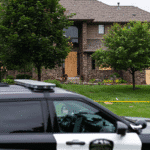An attempt at political assassination has left one Minnesota senator dead and another gravely injured in an astonishing and unheard-of act of violence. Two well-timed shootings in suburban areas startled the whole state on Saturday morning. Declining the attacks as politically motivated, Governor Tim Walz urged togetherness following the tragedy.
- Who Were the Victims in the Minnesota Attack?
- How Did the Minnesota Attacks Unfold Within Hours?
- Vance Luther Boelter is who? And why was he motivated?
- How did police find the suspect?
- How is the public and political response to the attack?
- This implies what is the direction of political safety going forward?
- What Lessons Can We Learn from the Minnesota Attack?
After a two-day manhunt, the biggest in state history, Vance Luther Boelter, the culprit, was arrested. Police verified that the assaults were planned and aimed at Democratic leaders. The violent outburst has spurred debates on public officials’ safety as well as the growing concerns confronting political leaders in the modern environment.
Who Were the Victims in the Minnesota Attack?
Both well-known Minnesota political personalities were among the targets of the political assassination effort. Shot and slain alongside her husband, Mark, at their Brooklyn Park house was Representative Melissa Hortman, a distinguished Democrat who spent 20 years serving in the state House and as Speaker from 2019 to 2025.
Also, targets were State Senator John Hoffman and his wife, Yvette. At their Champlin home, both had several gunshot wounds. The pair survived following surgery, although severely wounded. These heinous crimes have caused waves in Minnesota’s political and public spheres, sparking strong questions regarding the security of public representatives. Here is the link to our article on the Tunisia Election Arrest
How Did the Minnesota Attacks Unfold Within Hours?
Police report that the two events happened just hours apart, early Saturday morning. First responding to Senator Hoffman’s house at 2:00 AM following an emergency contact were the police. Then, about 3:35 AM, a second call brought them to Representative Hortman’s house in adjacent Brooklyn Park.
Law police at Hortman’s house observed an emergency vehicle sporting flashing lights. Appearing as a cop, a man impersonating a such opened fire on police, withdrew inside, then fled on foot. Later investigations revealed the deliberate character of the political assassination attempt by confirming that the suspect wore a vest, badge, and other police gear to enter the homes.
Vance Luther Boelter is who? And why was he motivated?
The assailant is Minnesota native Vance Luther Boelter, 57 years old. Along with Senator Hoffman, he once sat on the workforce development board for the state. Authorities found a troubling hit list in Boelter’s car, even though they have not identified a specific motivation. It included sites like Planned Parenthood offices as well as seventy names, mostly Democratic lawmakers.
Boelter has a varied background: he worked as a security contractor, a religious missionary in Africa, and employed food distributors and funeral companies in Minnesota. Posts on social media showed him preaching in the Democratic Republic of Congo. Though he travels a lot and has professional experience, his only past run-ins with the authorities were minor traffic offenses.
Just before the bombings, he also sent a disturbing text to friends declaring, “I’m going to be gone for a while.” Perhaps dead, not too far off. I adore you all and wish things had gone differently. This disturbing message gives the planned and deliberate character of the political assassination effort more weight.
How did police find the suspect?
Sunday night, the Boelters were caught in Green Isle, a rural community near their house. A tip directed police toward the culprit, who turned out to be hidden in a forest. Although he carried weapons when arrested, authorities put him into custody without incident or injuries.
Particularly those whose names appeared on Boelter’s target list, the arrest relieved law enforcement and politicians both. Investigators think he acted alone; no indication of a larger scheme exists right now. Still, the attempt at political murder using police impersonation begged more questions about the simplicity with which authority could be abused.
How is the public and political response to the attack?
Political leaders all across denounced the bloodshed. While Minnesota officials declared the attack an attack on democracy itself, a former U.S. president said such acts would not be accepted. Saying, “This cannot be the norm,” Governor Walz implored Minnesotans to transcend divisiveness and get back to constructive discourse.
Law enforcement stressed the need for vigilance and the gravity of the crime. Claiming that Boelter’s mistreatment of trust by posing as a police officer compromised first responders as well as citizens, they denounced The community has come together in favor of the relatives of the victims and demands that the political assassination attempt be investigated. Here is the link to our article on the Inauguration Tradition Shift
This implies what is the direction of political safety going forward?
Given this tragedy, many are advocating for more security policies for public leaders. From monitoring houses to assessing impersonation hazards, the attacks have made legislators reevaluate their safety.
The Minnesota case is a sobering reminder of the dangers political leaders face. Given the polarizing nature of politics, it is impossible to overlook the surge in deliberate violence. The political murder attempt in Minnesota has to be a turning point that motivates action not only to safeguard leaders but also to mend the split that causes such crimes.
What Lessons Can We Learn from the Minnesota Attack?
The latest political assassination attempt in Minnesota revealed a concerning increase in politically driven violence. Apart from costing lives, the deliberate attack on elected officials undermined public trust in political security. Stronger security systems and early threat detection are obviously now very crucial as research on this goes on. Beyond law enforcement, this occasion calls on everyone to stand against hate and extremism. Political differences never should excuse violence. Communities and leaders have to encourage togetherness, respect, and communication right now. Then democracy can stay robust.








